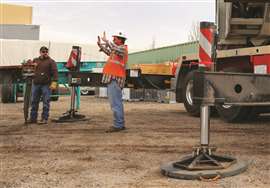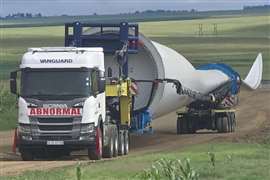How do you assure stable ground?
14 July 2025
Kris Koberg discusses how ground bearing capacity is a technical consideration and a critical safety issue.
 The ASME P30.1-2024 standard and OSHA regulations provide a clear framework of ground stabilization measures that must be implemented.
The ASME P30.1-2024 standard and OSHA regulations provide a clear framework of ground stabilization measures that must be implemented.
Up to 90 per cent of crane-related accidents can be attributed to human error, with 54 per cent of incidents due to improper outrigger use.
This statistic, provided by the Crane Inspection & Certification Bureau (CICB) in the USA, highlights the importance of ensuring outriggers are properly deployed, ground conditions are assessed and adequate supporting materials are used to distribute outrigger loads effectively.
Here are the primary issues:
- Controlling entities (CEs) are responsible for the ground.
- Typically, an allowable ground bearing pressure is not provided to crane rental companies.
- Most crane rental companies typically do not specify the ground strength required for safe operation, leaving this essential detail to the discretion of the contractor they work for.
- Most crane rental companies do not use a standard approach to determine the area or type of supporting materials they send with the crane.
Ground responsibility
OSHA 1926.1402(b) specifies that the controlling entity (CE) is responsible for the ground, and they must provide ground conditions that are drained and graded so that, in conjunction with supporting materials, the equipment manufacturer’s specifications for adequate support and degree of level are met. 1926.1402(e) further clarifies: If the assembly and disassembly (AD) director or the operator determines that ground conditions do not meet the requirements (paragraph (b) noted above), then the person’s employer must have a discussion with the controlling entity regarding the ground preparations that are needed so that, with the use of suitable supporting materials/devices (if necessary) to ensure the requirements in paragraph (b) can be met.
Most crane work, however, is hired as taxi-service, and the ability to appropriately determine the allowable ground bearing pressure is not a reality. One lift planner recently said, “If you are given an allowable ground bearing pressure, you should run out and buy a lottery ticket, because it’s your lucky day!”
Properly supporting equipment to protect people, equipment and worksites is a two-way street. The crane rental company has a duty to communicate key information to the CE. And the CE has a duty to communicate information to the crane rental company. To help foster clear communication between all parties, crane rental companies should be encouraged to establish and provide the required ground bearing capacity to safely perform the work. Establishing a minimum required ground bearing capacity is a best practice now recommended by industry insurance companies and is gaining traction among crane rental companies nationwide.
Wake-up call
Much of the litigation concerning ground conditions has resulted in a loss for the crane rental company when they did not specify a required ground bearing capacity. These results should be a wake-up call for equipment providers to specify their required ground bearing capacity in their quotes, bids, job tickets and any other documentation they provide. Establishing a minimum ground bearing capacity is essential to reducing risk, enhancing collaboration and mitigating risk.
Allowable ground bearing capacity
The basic approach to establishing the ground bearing capacity you need is to define a maximum ground bearing pressure that the equipment will exert. The good news is that the inputs are straightforward. Simply put, the result of dividing the Force (Outrigger Reaction Force) by the Area (Supporting Materials) will be the maximum ground bearing pressure exerted on the ground. Let’s work with each variable.
Force (outrigger reaction force)
The force will either be the maximum outrigger reaction force for the crane, or the maximum outrigger reaction force that is reduced by a factor based on any operating limitations you may establish. An adjustment can be considered if the crane is configured with something less than the maximum counterweight. Another example of an adjustment can be considered is if the use of the crane is limited to a lower percentage of the chart. Establishing a Peak Outrigger Reaction force based on your guidelines for each crane you own is step one to standardize and simplify the selection of supporting materials and the establishment of a minimum ground bearing capacity.
Area (supporting materials). The area you use to distribute the force to the ground is an essential second step. The minimum area would be the area of the outrigger float. As noted above, OSHA does not mandate the use of supporting materials. However, supporting materials must be used to ensure that the “manufacturer’s specifications for adequate support and degree of level are met.” Using supporting materials for all lifts is highly recommended. With that said, the area of supporting materials can be established based on the minimum ground bearing capacity, or the ground bearing capacity can result from the supporting materials’ area. We encourage you to be intentional and base the area of supporting materials on the minimum ground bearing capacity. Below is an example of the approach.
Inputs and decisions:
- The maximum outrigger reaction force for the crane is 100,000 pounds
- You determine that the reaction force will not exceed 75 percent of the maximum based on your operational limitations.
- You have established a maximum ground bearing pressure of 3,500 psf.
Results:
- Define the Force. In this case, you would multiply 100,000 pounds 75 per cent. The resulting force for this calculation is 75,000 pounds. (100,000 x 75 percent = 75,000 pounds)
- The force of 75,000 pounds divided by the maximum ground bearing pressure of 3,500 psf is 21.5 square feet. (75,000 pounds / 3,500 psf = 21.5 sf)
Now you need to do two things. First, a qualified person needs to determine the appropriate materials, thickness of materials, or system design to effectively distribute the loads and pressures to the intended levels. Supporting materials manufactured from materials such as steel, wood, and synthetic material, that are in good condition, should be used to distribute loads over the minimum area to reduce the chances of ground failure. ASME P30 has outlined several methods for material evaluation in its non-mandatory appendix. Second, communicate to the CE that you require a supporting surface capable of safely supporting ground bearing pressures of 3,500 psf.
Establishing a minimum ground bearing capacity and communicating it to the CE is not just a technical consideration; it’s a critical safety issue that demands shared responsibility, clear communication, and adherence to standards. The ASME P30.1-2024 standard and OSHA regulations provide a clear framework, but it’s up to every stakeholder – from the controlling entity to the crane provider, lift planner, and engineer – to ensure those frameworks are implemented.
Only through proactive collaboration, transparency, and a commitment to continuous education can the industry reduce risk, protect workers, and improve project performance. Ground stability isn’t just about the crane – it’s the foundation for safe, efficient, and accountable lifting operations.

ABOUT THE AUTHOR
Kris Koberg is president and CEO at Dica, a family-owned manufacturer and distributor of supporting materials, ground protection, site access mats and associated products. He is active in industry initiatives, including ASME P30 committee, North American Matting Association technical committee, and he recently chaired the SC&RA task force to create “A Guide to Outrigger Pad Materials, Selection and Usage.” For more information visit www.dicausa.com.
STAY CONNECTED


Receive the information you need when you need it through our world-leading magazines, newsletters and daily briefings.
CONNECT WITH THE TEAM











